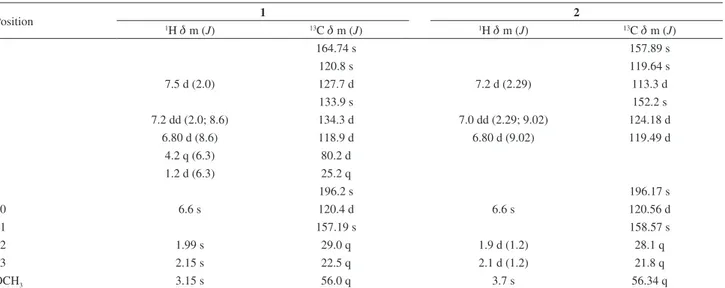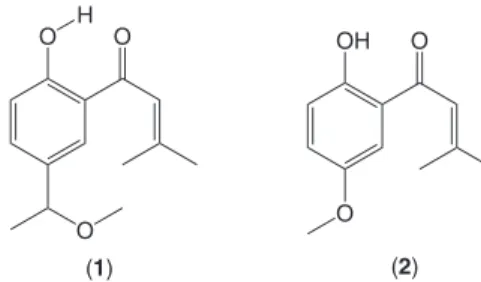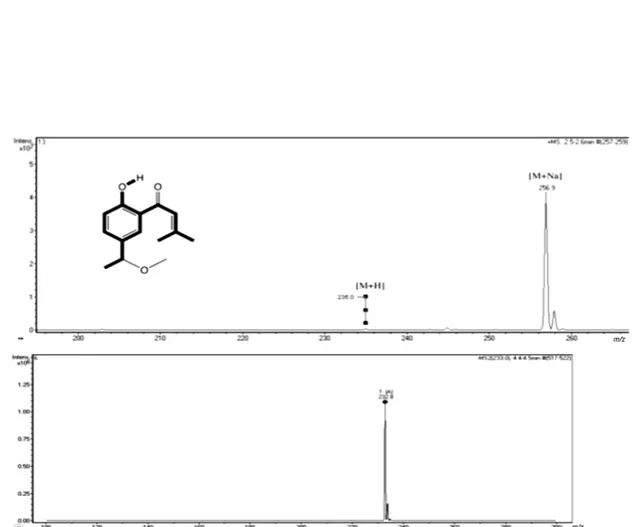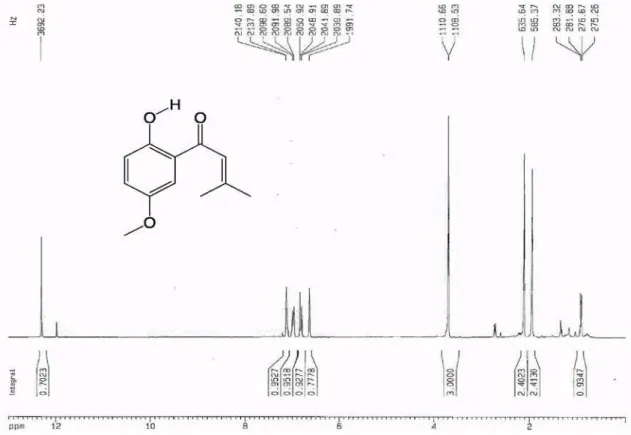Short Report
S
J. Braz. Chem. Soc., Vol. 22, No. 12, 2391-2395, 2011.Printed in Brazil - ©2011 Sociedade Brasileira de Química 0103 - 5053 $6.00+0.00
*e-mail: miltongoba@uniquindio.edu.co
Topical Anti-Inflammatory Activity of
Calea prunifolia
HBK
(Asteraceae) in the
TPA Model of Mouse Ear Inflammation
Milton Gómez* and Juan F. Gil
Grupo de Búsqueda de Principios Bioactivos, Programa de Química, Universidad del Quindío, Armenia, Colombia
O estudo fitoquímico de Calea prunifolia identificou dois compostos derivados de
p-hidroxiacetofenona, a 1-(2-hidroxi-5-(1-metoxietil)fenil)-3-metilbut-2-en-1-ona apresentou atividade anti-inflamatória satisfatória (58.33%), tratando-se de um produto natural. Apesar dos dois compostos derivados serem estruturalmente semelhantes, a atividade anti-inflamatória da 1-(2-hidroxi-5-metoxifenil)-3-metilbut-2-en-1-ona não foi significativa (2.08%). O ensaio foi realizado em modelo de inflamação induzido por 12-O-tetra-decanoilforbol-13-acetato (TPA) em orelha de ratos. O controle positivo foi testado com indometacina e foram ensaiados controles negativos tratados somente com o veículo. Estes resultados possibilitam a identificação de um grupo farmacóforo que através de estudos de modelagem molecular e síntese orgânica podem resultar em compostos com atividade anti-inflamatória melhorada.
Phytochemical study of Calea prunifolia HBK identified two compounds derived from
p-hydroxyacetophenone, the 1-(2-hydroxy-5-(1-methoxyethyl)phenyl)-3-methylbut-2-en-1-one showed a satisfactory anti-inflammatory activity (58.33%), when considering that this is a natural product. Although the two derived compounds are structurally similar, the anti-inflammatory activity of 1-(2-hydroxy-5-methoxyphenyl)-3-methylbut-2-en-1-one was not significant (2.08%). The test was conducted in a model of inflammation induced by topical application of 12-O-tetradecanoylphorbol-13-acetate (TPA) in the ear of mice. The positive control was tested with indomethacin and the negative control was done only with vehicle. These results allow the identification of a pharmacophore group that through molecular modeling studies and organic synthesis can result in compounds with improved anti-inflammatory activity.
Keywords: Calea prunifolia HBK, anti-inflammatory activity, mouse edema
Introduction
The inflammatory process is a physiological response to injuries, traumas, bone fracture, hypersensitivity reactions and other diseases,1,2 and causes an accumulation
of fluid, blood cells, cellular and extracellular constituents of connective tissue and produce pain.3 Many current
anti-inflammatory drugs are synthetic, and their toxicity and reappearance of symptoms after discontinuation are a common problem.4,5 These untoward effects restrict their
long-term use.6 Hence, there is a constant demand for better
therapeutic alternatives. For this reason, the search for new anti-inflammatory drugs is directed to the research of new hit molecules in plants traditionally used as medicinal,7-12 which
can be modified using organic synthesis to improve activity. The genus Calea is part of the Asteraceae family, which is known for its diverse and important pharmacological
activities: antimicrobial, vasodilating activity and others.13
In the searching for compounds, non-steroidal anti-inflammatory agents/analgesics (NSAIDs) show a promising potential because this activity in several genus of plants of this family have been widely reported.1,14-16 The reason for
this property is the secondary metabolites that these plants possess. It has been particularly reported in studies involving the Calea prunifolia HBK the presence of metabolites like as sesquiterpene, acorane,17 eudesmanolides, guaianolides,18
flavonoids and other.19 So, the aim of this work is to evaluate
the anti-inflammatory activity of Calea prunifolia HBK and the isolation of an active agent.
Experimental
Vegetal material
Topical Anti-Inflammatory Activity of Calea prunifolia HBK (Asteraceae) J. Braz. Chem. Soc.
2392
(HBK: COL468655) was deposited in the Herbarium of the Universidad Nacional de Colombia (HUN).
General procedure
1H, 13C and 2D nuclear magnetic resonance (NMR)
spectra of isolated compounds were recorded on a Bruker DRX 300, operating at 300 MHz for 1H and 75 MHz for 13C. Chemical shifts (d) were reported in ppm and coupling
constants (J) in Hz, CDCl3 was used as solvent and
internal standard. In the direct infusion mass spectrometry (DIMS) technique, the sample was directly injected into the electrospray ionization (ESI) source in the mass spectrometer equipment with ion trap detector (Agilent model SL 6300 series). ESI-MS spectra (positive or negative mode) were acquired from m/z 100-400. The following parameters were used: capillary temperature of 275 °C, capillary voltage of 20 V, spray voltage of 5 kV, tube lens of −5 V. UV-Visible spectra were recorded in a ThermoScientific Genesys 10S Spectrometer. Infrared spectra were acquired in KBr with a ThermoNicolet Avatar 330. Silica gel 60 (200-300 mesh, Merck) was used for all separations. While silica gel 60 F254 (Merck) was
used for analytical thin layer chromatography (TLC), the compounds were detected under UV light (254, 366 nm) and by spraying with vanillin/H3PO4 followed by heating.
Extraction and isolation
Dried and ground leaves from Calea prunifolia HBK were exhaustively extracted by percolation with EtOH at room temperature and the extract was concentrate under
vacuum and at 35 ºC. The crude extract was chromatographed on a silica gel column with CH2Cl2 obtaining five fractions
(F1-F5) followed by CH2Cl2:EtOAc mixtures of increasing
polarity. Four fractions were collected (F6-F9), the last fraction was obtained using MeOH (F10), 500 mL of solvent was used in each fraction. Fractions 2-3 yielded compound 1 and fractions 4-5 gave compound 2.
1-(2-Hydroxy-5-(1-methoxyethyl)phenyl)-3-methylbut-2-en-1-one (1)
Yellow crystal; UV (MeOH) λ
max/nm (log ε): 220
(4.04), 274 (4.13), 344 (3.56); IR (KBr) ν
max/cm
-1: 3436
(OH), 1638 (C=O), 1580 (o-hidroxyacetone), 1486 (Ar); DIMS m/z (relative intensity): 256.9 [M + Na]+ (100), 235.0
[M + H]+ (10) in positive mode and 232.8 [M − H]− (100)
in negative mode (calc. for C14H18O3: 234.0); for 1H and
13C NMR spectroscopic data, see Table 1.
1-(2-Hydroxy-5-methoxyphenyl)-3-methylbut-2-en-1-one (2)
Yellow oil; UV (MeOH) λ
max/nm (log ε): 220 (4.04),
272 (4.08), 372 (3.58); IR (KBr) ν
max/cm
-1: 3513 (OH),
1643 (C=O), 1585 (o-hidroxyacetone), 1488 cm-1 (Ar);
DIMS m/z (relative intensity): 228.9 [M + Na]+ (100), 206.9
[M + H]+ (10) in positive mode and 204.8 [M − H]− (100)
in negative mode (calc. for C12H14O3: 206,24); for 1H and
13C NMR spectroscopic data, see Table 1.
Animals
Female ICR mice (25-30 g) were obtained from animal facility at the Department of Pharmacy of the
Table 1.1H and 13C NMR data of compounds 1 and 2 (CDCl
3, d values)
Position 1 1 2
H d m (J) 13C d m (J) 1H d m (J) 13C d m (J)
1 164.74 s 157.89 s
2 120.8 s 119.64 s
3 7.5 d (2.0) 127.7 d 7.2 d (2.29) 113.3 d
4 133.9 s 152.2 s
5 7.2 dd (2.0; 8.6) 134.3 d 7.0 dd (2.29; 9.02) 124.18 d
6 6.80 d (8.6) 118.9 d 6.80 d (9.02) 119.49 d
7 4.2 q (6.3) 80.2 d
8 1.2 d (6.3) 25.2 q
9 196.2 s 196.17 s
10 6.6 s 120.4 d 6.6 s 120.56 d
11 157.19 s 158.57 s
12 1.99 s 29.0 q 1.9 d (1.2) 28.1 q
13 2.15 s 22.5 q 2.1 d (1.2) 21.8 q
OCH3 3.15 s 56.0 q 3.7 s 56.34 q
Gómez and Gil 2393 Vol. 22, No. 12, 2011
Universidad Nacional de Colombia. The experiments were conducted in accordance with the guidelines of the Ethics Committee of the Universidad Nacional de Colombia and the international ethical guidelines for the care and use of experimental animals.20 The female ICR mice were fed
according to a standard diet, food and water access was ad libitum, and kept under controlled climatic conditions, photoperiods equal to 12 h of light with environmental temperature at 21 °C. The test included the substances under study. It was administrated for the negative control group only the vehicle and the positive control group received indomethacin as reference drug.
Ear edema in mice induced by TPA (12-O-tetra-decanoylphorbol-13-acetate)
Edema was induced in both ears of each mouse by the topical application of 2.5 µg TPA dissolved in 20 µL of acetone to both the inner and outer ear surfaces (10 µL per side). Later, the substances under testing (extracts and compounds) dissolved in acetone were applied in the right ear in a concentration of 500 µg per ear, using indomethacin as reference substance in all cases, the left ear was negative control, receiving only vehicle. Four hours later, mice were sacrificed and a plug (∅ 6 mm) was removed from both the treated and the untreated ears. The weight difference between right and left ears was taken as an expression of edema. The results were expressed as edema and as percentage of inhibition versus the control group.3,12,19,22
Results and Discussions
Structural elucidation
1-(2-Hydroxy-5-(1-methoxyethyl)phenyl)-3-methylbut-2-en-1-one (1)
The DIMS spectrum showed a quasi-molecular ion peak at m/z 235 and 233 in [M + H]+ and [M − H]− mode,
respectively, corresponding to a molecular weight of 234 m/z, compatible with the molecular formula C14H18O3.
The 1H NMR (Table 1) and homonuclear correlation
spectroscopy (COSY) NMR spectra showed the presence of an AB system at d 7.5 (d, J 2.0 Hz, H-3), 7.2 (dd, J 8.6 and 2.0 Hz, H-5) and 6.80 (d, J 8.6 Hz, H-6); a vinyl hydrogen at d 6.6 ppm (s, H-10); a methoxyl at d 3.15 (s); two singlet at chemical shift 2.15 (H-13) and 1.99 (H-12), indicative of methyl groups in a isoprene system, and another methyl group at d 1.2 ppm (d, J 6,3 Hz, H-8) coupled in COSY NMR to a methine signal at d 4.2 (q, J 6.3 Hz, H-7). The 13C NMR spectrum (Table 1) showed
four signals corresponding to CH3 group with chemical
shifts d 56.0, 29.0, 25.2 and 22.5. The one corresponds to a methoxyl group as substituent at C-7, the third to methyl in C-8, finally, the second and four correspond to two methyl groups on double bond of isoprene system C-12 and C-13. The signal at d 196.2 ppm was attributed to the carbonyl carbon, the signals d 164.74, 134.3, 133.9, 127.7, 120.8 and 118.9 correspond to a six aromatic carbon atoms in a benzene ring. Besides this, the structure was elucidated with the help of 2D NMR techniques: heteronuclear single-quantum correlation spectroscopy (HMQC) and heteronuclear multiple-bond correlation spectroscopy (HMBC). The HMBC experiment showed correlations of C-1 (d 164.74) with H-3 (d 7.5) and H-5 (d 7.2); C-2 (d 120.8) with H-6 (d 6.80) and H-3 (d 7.5), similarly, H-7 (d 4.2) correlates with the C-4 (d 133.9) and C-5 (d 134.3). The position of de quaternary carbon C-4 was obtained through HMBC correlation with the CH3 at (d 1.2).
1-(2-Hydroxy-5-methoxyphenyl)-3-methylbut-2-en-1-one (2)
Comparing the spectroscopic data of the compound 1 and
2 and the literature,18,22,23 it was possible to determine the
structure of the second, with some differences between both. In the compound 2, the methoxyl group is bonded directly to aromatic ring C-4, that way, this carbon showed a higher chemical shift, C-4 (d 152.2), affecting the C-3 with
d 113.3. The other difference was the absence of carbons C-7 and C-8. The structures are showed in Figure 1.
These compounds have been previously isolated from Calea uniflora and Calea peckii, 1 and 2 respectively, as well as compound 1 has been tested on their biological activity against trypanosoma parasites and fungi.
Anti-inflammatory activity
The difference between the ear weights of the one only treated with TPA and the one treated with the compounds indicates the percentage of inhibition (I / %) of the inflammatory action (Table 2). In this sense, when it is compared the weight of the ears of untreated mice (8.0 mg), the weight of those treated with compound 1 (3.3 mg),
Figure 1. Structures of compounds 1 and 2.
O O OH O O O
(1) (2)
Topical Anti-Inflammatory Activity of Calea prunifolia HBK (Asteraceae) J. Braz. Chem. Soc.
2394
giving 58.33% of inhibition. This result when compared with the weight of ears of mice treated with indomethacin (1.5 mg) with an anti-inflammatory activity of 81.25% (of inhibition), it is not very appreciable. On the other hand, the activity is considered high when comes to a natural product.
The TPA ear edema model in mice is useful to testing pharmaceutical agents or natural products with prospective anti-inflammatory activity involved in the inhibition of arachidonic acid pathway.19,24 Products of arachidonic acid
metabolism, such as PGI2 and LTB4, increase vascular
permeability leading to edema during the inflammatory response. So, the use of inhibitors of phospholipase framed in the synthesis of AA, such as corticoids, has marked anti-inflammatory action. Likewise, compounds of inhibiting cyclooxygenase (COX) and lipoxygenase (LOX) enzymes have been shown to inhibit TPA induced inflammation.19,25
The main mechanism of action of non-steroidal anti-inflammatory agents/analgesics (NSAIDs) is involved in the inhibition of COX/LOX enzymes, in addition, some aromatic compounds, such as acetylsalicylic acid (which has a mode of anti-inflammatory action by irreversible suppression of the enzyme COX 1), hamper the synthesis of prostaglandins by decreasing of the inflammation. Similarly, some acrylic acids, such as 4-hydroxybenzene derivatives, are able to engage with the active site of the cyclooxygenase and lipoxygenase enzymes.26
Therefore, it is possible to presume that the anti-inflammatory action shown by compound 1 is due to the intervention of this compound to the COX or LOX enzymes involved in the synthesis of prostaglandins resulting in the decreased inflammatory event.
Taking into account the mode of action of this molecule and the type of used assay by testing the
compounds, we propose the possible mode of action of the molecule 1,which suggests an irreversible attachment in an active site of an enzyme involved in inflammation, a process that is restricted in the molecule 2.
Conclusions
Assuming that the difference between the molecules is minimal, the compounds isolated from Calea prunifolia HBK are likely to be synthetically modified to enhance anti-inflammatory activity with the aim of achieving an active and safe compound.
Supplementary Information
The spectra are provided as Supplementary Information and available free of charge at http://jbcs.sbq.org.br as PDF file.
Acknowledgments
The authors thank the Universidad Nacional de Colombia (Bogotá, Colombia) and the Universidad del Quindío (Armenia, Colombia).
References
1. Castelucci, S.; Rogerio, A.; Ambrosio, S.; Arakawa, N.; Lira, S.; Faccioli, L.; Costa, F.; J. Ethnopharmacol.2007, 112, 192. 2. Gené, R. M.; Cartaña, C.; Adzet, T.; Mará n, E.; Parella, T.;
Canigueral, S.; Planta Med.1996, 62, 232.
3. Ojewole, J. A. O.; J. Ethnopharmacol.2007, 113, 338. 4. Armstrong, E. P.; Malone, D. C.; Clin. Ther.2003, 25, 1. 5. Hull, M. A.; Gardner, S. H.; Hawcroft, G.; Cancer. Treat. Rev.
2003, 29, 309.
6. Raghav, S.; Gupta, B.; Agrawal, C.; Goswami, K.; Das, H.;
J. Ethnopharmacol.2006, 104, 234.
7. Sosa, S.; Balick, M. J.; Arvigo, R.; Esposito, R. G.; Pizza, C.; Altinier, G.; Tubaro, A.; J. Ethnopharmacol.2002, 81, 211. 8. Flodmark, C. A.; Bruhn, J. G.; Bohlin, L.; Drug Discovery
Today2001, 6, 455.
9. Abad, M. J.; Bermejo, P.; Carretero, E.; Martínez-Acitores, C.; Noguera, B.; Villar, A.; J. Ethnopharmacol.1996, 55, 63. 10. Ruppelt, B. M.; Pereira, E. F. R.; Gonçalves, L. C.; Pereira,
N. A.; Mem. Inst. Oswaldo Cruz1991, 86, 203.
11. Fawole, O. A.; Ndhlala, A. R.; Amoo, S. O.; Finnie, J. F.; Van Staden, J.; J. Ethnopharmacol.2009, 123, 237.
12. Amresh, G.; Reddy, G.; Rao, C.; Singh, P.; J. Ethnopharmacol.
2007, 110, 526.
13. Ingrid L. Onzaga; Rincón, J.; Guerrero, M. F.; Colomb. Med.
2008, 39, 33.
Table 2. Anti-inflammatory activity results
n Control Indomethacin
Compounds
1 2
Dpa / mg Dpa / mg Dpa / mg
1 5 0 2 4
2 4 3 5 11
3 16 0 3 5
4 7 4 5 9
5 7 0 3 10
6 9 2 2 8
M + SDb / mg 8.0c ± 3.9 1.5c ± 1.6 3.3c ± 1.2 7.8c ± 2.5
I / %d 0 81.25 58.33 2.08
Gómez and Gil 2395 Vol. 22, No. 12, 2011
14. dos Santos, D. A.; Fukui, M. D. J.; Nanayakkara, N. P. D.; Khan, S. I.; Sousa, J. P. B.; Bastos, J. K.; Andrade, S. F.; Silva Filho, A. A.; Quintão, N. L. M.; J. Ethnopharmacol.
2010, 127, 543.
15. Alves, K.; Gobboneto, L.; Lopes, N.; Biochem. Syst. Ecol.2008,
36, 434.
16. Hamburger, M.; Adler, S.; Baumann, D.; Förg, A.; Weinreich, B.; Fitoterapia2003, 74, 328.
17. Castro, V.; Jakupovic, J.; Bohlmann, F.; J. Nat. Prod.1984, 47, 802.
18. Castro, V.; Tamayo-Castillo, G.; Jakupovic, J.; Phytochemistry
1989, 28, 2415.
19. Bralley, E. E.; Greenspan, P.; Hargrove, J. L.; Wicker, L.; Hartle, D. K.; J. Inflamm.2008, 5, 1.
20. http://www.dib.unal.edu.co/promocion/etica_res_8430_1993. pdf accesed in August 2011.
21. Franco, L. A.; Matiz, G. E.; Calle, J.; Pinzón, R.; Ospina, L. F.
Biomédica2010, 27, 110.
22. do Nascimento, A. M.; Salvador, M. J.; Candido, R. C.; de Albuquerque, S.; de Oliveira, D. C. R.; J. Pharm. Pharmacol.
2004, 56, 663.
23. Ober, A. G.; Urbatsch, L. E.; Fischer, N. H.; Phytochemistry
1985, 24, 795.
24. Puigneró, V.; Turull, A.; Queralt, J.; Inflammation1998, 22, 307.
25. Fujimori, S.; Seo, T.; Gudis, K.; Ehara, A.; Kobayashi, T.; Mitsui, K.; Yonezawa, M.; Tanaka, S.; Tatsuguchi, A.; Sakamoto, C.; Gastrointest. Endosc.2009, 69, 1339.
26. Mao, J.-L.; Ran, X.-K.; Tian, J.-Z.; Jiao, B.; Zhou, H.-L.; Chen, L.; Wang, Z.-G.; Bioorg. Med. Chem. Lett.2011, 21, 1549.
Supplementary Information
S
I
J. Braz. Chem. Soc., Vol. 22, No. 12, S1-S8, 2011. Printed in Brazil - ©2011 Sociedade Brasileira de Química 0103 - 5053 $6.00+0.00
*e-mail: miltongoba@uniquindio.edu.co
Topical Anti-Inflammatory Activity of Calea prunifolia HBK (Asteraceae) in the
TPA Model of Mouse Ear Inflammation
Milton Gómez* and Juan F. Gil
Grupo de Búsqueda de Principios Bioactivos, Programa de Química, Universidad del Quindío, Armenia, Colombia
Topical Anti-Inflammatory Activity of Calea prunifolia HBK (Asteraceae) J. Braz. Chem. Soc.
S2
Figure S2. HMQC NMR spectrum (CDCl3) of compound 1.
Gómez and Gil S3 Vol. 22, No. 12, 2011
Figure S4. HMBC expansion NMR spectrum (CDCl3) of compound 1.
Topical Anti-Inflammatory Activity of Calea prunifolia HBK (Asteraceae) J. Braz. Chem. Soc.
S4
Figure S6. IR spectrum (KBr) of compound 1.
Gómez and Gil S5 Vol. 22, No. 12, 2011
Figure S8. 1H NMR spectrum (CDCl
3) of compound 2.
Figure S9. 13C NMR spectrum (CDCl
Topical Anti-Inflammatory Activity of Calea prunifolia HBK (Asteraceae) J. Braz. Chem. Soc.
S6
Figure S10. J-MOD NMR spectrum (CDCl3) of compound 2.
Gómez and Gil S7 Vol. 22, No. 12, 2011
Figure S12. HMBC NMR spectrum (CDCl3) of compound 2.
Topical Anti-Inflammatory Activity of Calea prunifolia HBK (Asteraceae) J. Braz. Chem. Soc.
S8
Figure S14. IR spectrum (KBr) of compound 2.









